
With the harvest from our garden, and stops at roadside stands and farmers markets, my family ends up with a lot of fruits and vegetables that we want to preserve and enjoy throughout the year, not just while they are in season. While I really enjoy canning now and again, in my case, it’s all about freezing fruits and vegetables for smoothies.
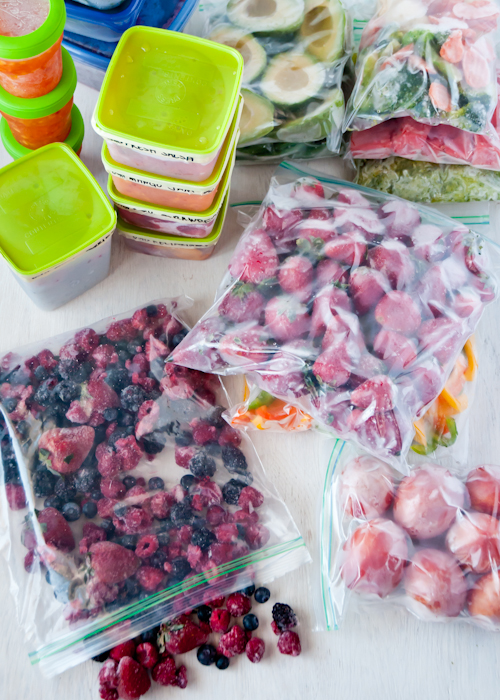
FREEZING PRODUCE FOR SMOOTHIES – A COMPLETE GUIDE
Frozen Food Is Fresher Tasting Than Canned Food
There’s a reason for that. I find that some things are quicker to preserve when freezing, like berries. And other produce is fresher tasting and the quality is a bit better when freezing instead of canning. Plus, confession: I just don’t like canned veggies all that much. So, freezing it is!
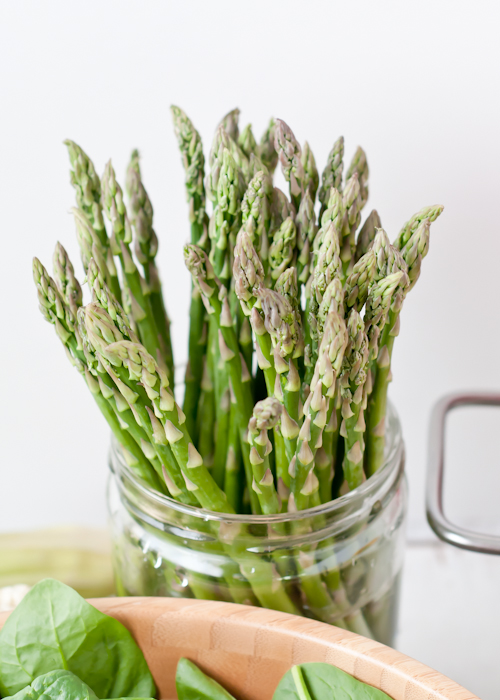

Remember last summer when we covered the basics of washing and storing produce? Consider this the companion to that post.
Freezing Produce Requires Planning & Proper Equipment
As with canning, freezing produce requires a little bit of planning and gathering the proper equipment. While canning relies on heat to kill microbes, which then also destroys some of the nutritional value, freezing delays the growth of bacteria and slows the work of enzymes, which keeps the food preserved. That’s not to say that frozen food isn’t as safe as canned food. It’s just a different way to do it.

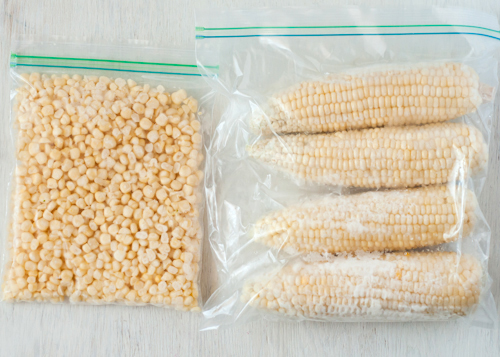

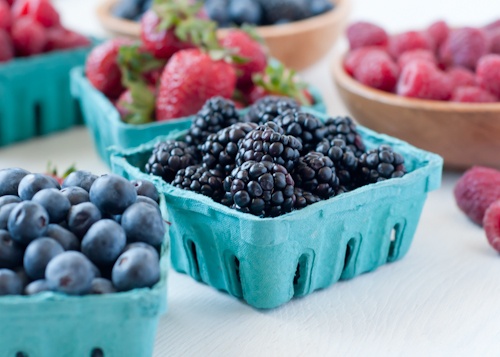
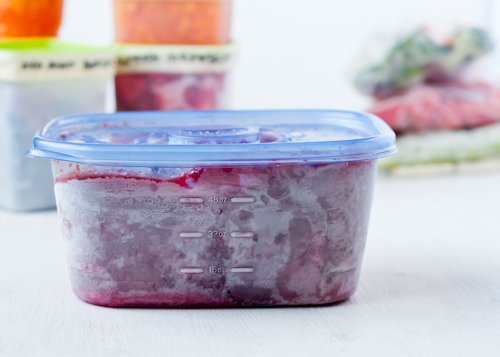
A big plus for freezing produce is that it ends up tasting much fresher and contains more nutrients than canned produce.
But there is a draw back as well. The texture of thawed veggies and fruit can be undesirable. In the process of freezing, the water within the fruits and veggies turns to ice. As it does, it expands which causes cell walls to burst. This can equal mushy texture when thawed.
But there are steps you can take to ensure higher quality frozen fruits and veggies — similar to the ones you buy at the grocery store. And we’ll cover those below.
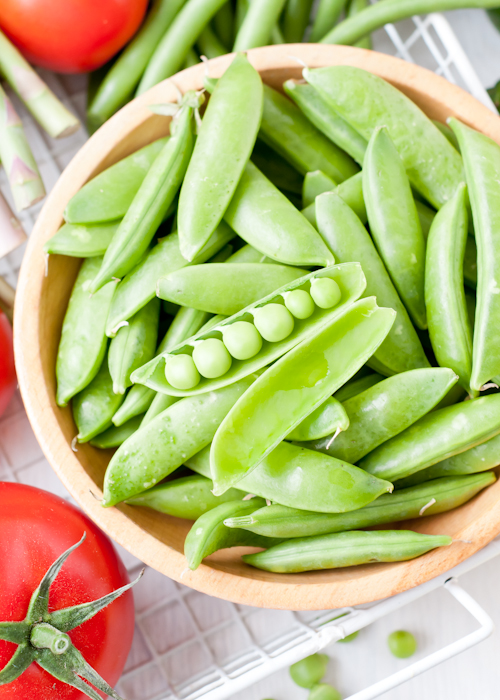
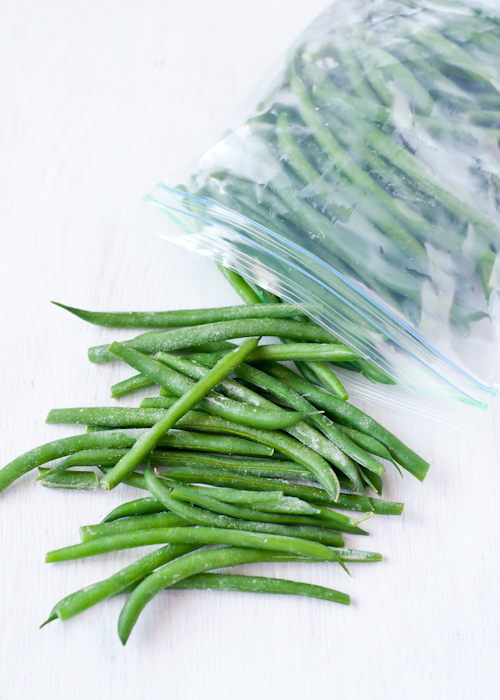
First let’s talk about the materials you’ll need to assemble before you start.

Materials for Freezing Produce
Secret #1: Something great thing about freezing fruits and vegetables is that you don’t really need fancy equipment. Freezer bags come in handy for “dry pack” freezing that doesn’t involve using syrups or purees. Rigid plastic containers, glass containers, and jars come in handy for liquid or semi-solid foods, sauces, jams, and other preserves.
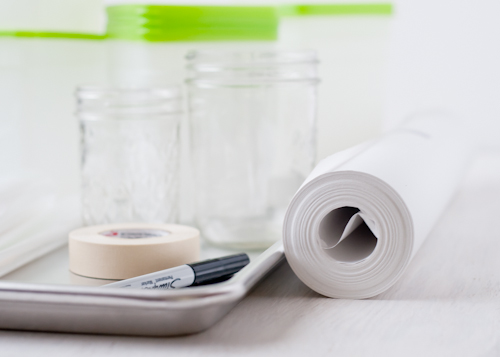
In addition to containers, I also recommend freezer paper, freezer tape, and heavy-duty foil. They come in handy for packaging certain foods and for long-term storage. Long term means longer than the typical 6-12 months. The longer you store the food in the freezer, the more the quality declines, but it is still perfectly fine to eat.
Another essential for me is a rimmed baking sheet. I use it to quickly freeze individual pieces of whole or sliced produce. More on that in a bit.
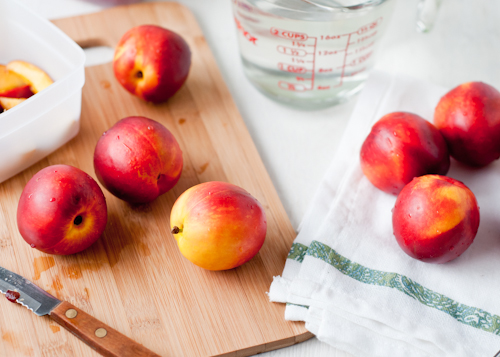
How to Prepare Fruits & Vegetables for Freezing
You’ll want to wash all fruits and vegetables well, especially if you don’t plan on peeling them, and pat them dry with a paper towel or dishtowel. Some fruits and vegetables can be frozen whole, while others need to be peeled, pitted, and/or cut into smaller pieces. A bit of it is personal preference, but some produce definitely does better in the freezer when cut into smaller pieces.
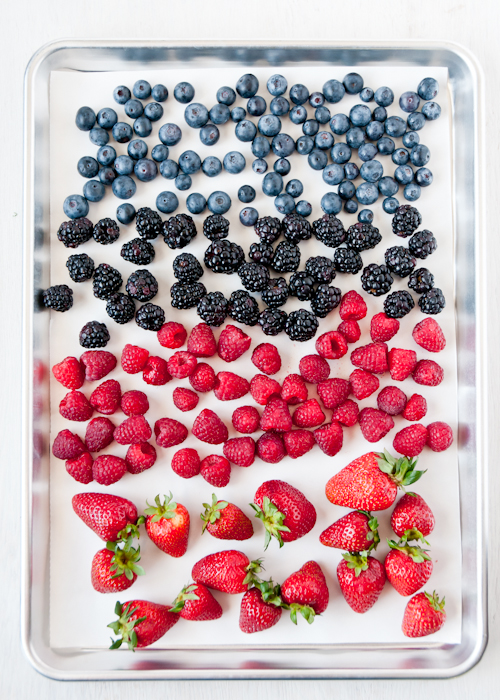
Secret #2: Fruits and veggies that do exceptionally well frozen whole:
Berries (raspberries, strawberries, blueberries, blackberries, currants, cranberries, etc.), bananas, chili peppers, beans, asparagus, tomatoes, and corn.
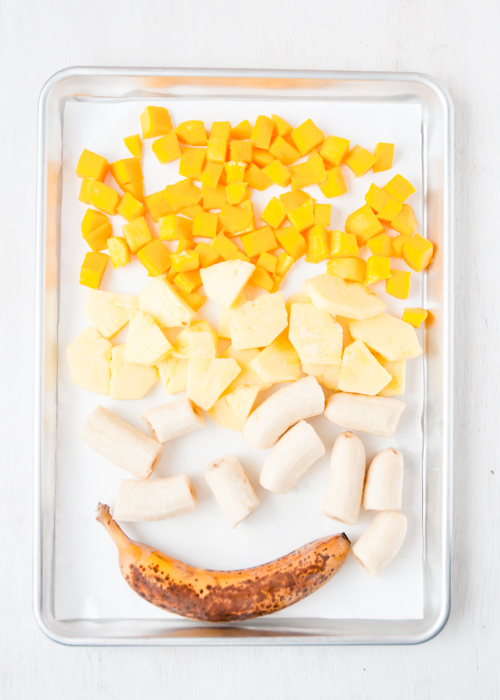
Secret #3: Produce that does well sliced or diced:
Bell peppers, avocado, mango, pineapple, melon, peas, carrots, broccoli, cauliflower, stone fruits (peaches, nectarines, plums, cherries), apples (yes, you can freeze apples!), summer squash, and winter squash.
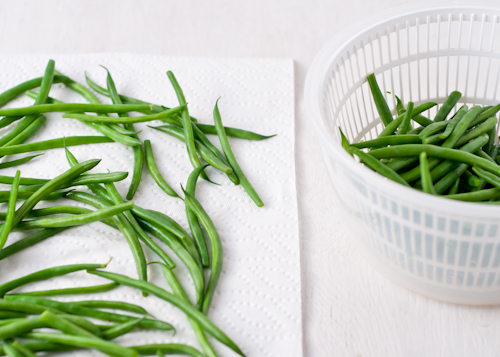
Cut broccoli and cauliflower into florets. Shell peas, trim the ends of green beans and asparagus. Dice or slice peeled carrots, squash, brussels sprouts, and large leaves of spinach, chard, and kale. Rhubarb should be trimmed of woody ends and diced.
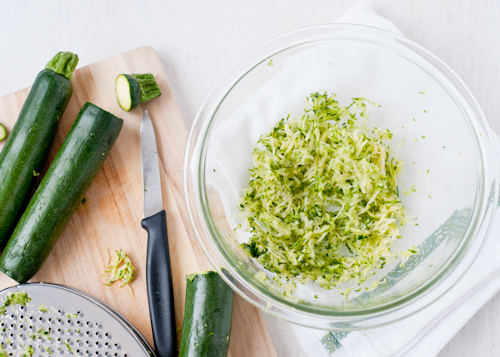
Potatoes can be frozen, but benefit from being shredded. Think: hashbrowns. (Note: I personally don’t like freezing potatoes at home. The quality just isn’t as good.) Zucchini is another veggie with a high water content. It can be sliced or diced and frozen, but I prefer shredding it instead.
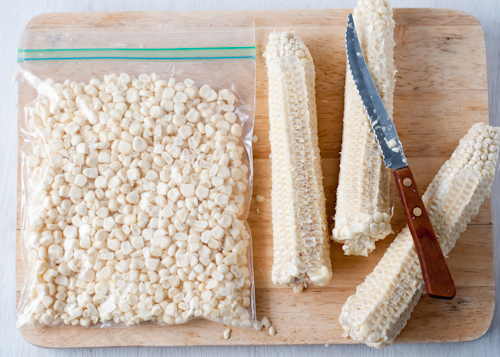
Corn and bananas are pretty versatile when it comes to freezing. Corn can be frozen whole or cut from the cob. It’s totally up to you! I think it’s one of the best veggies for freezing because the quality isn’t as affected by the cold temperatures.
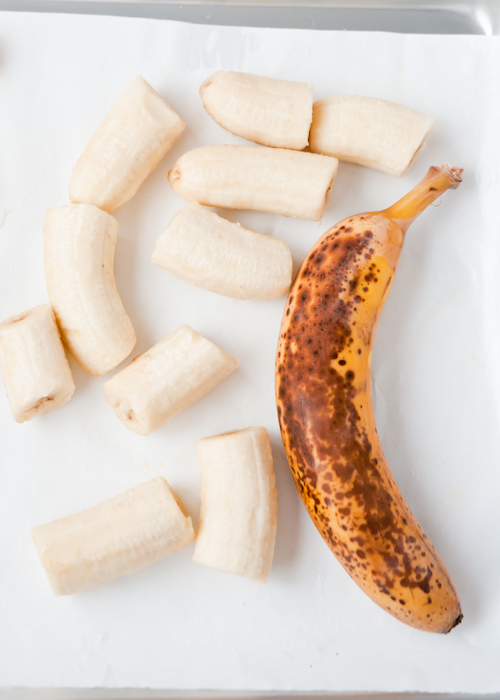
Bananas can be frozen whole and unpeeled, or peeled and whole, or peeled and cut. They’re pretty fabulous that way! I can’t resist adding a frozen banana to my daily smoothie to sweeten it up without adding sugar.
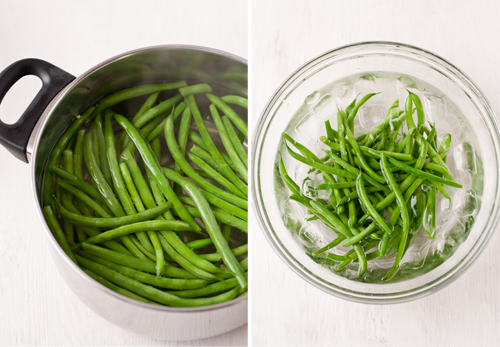
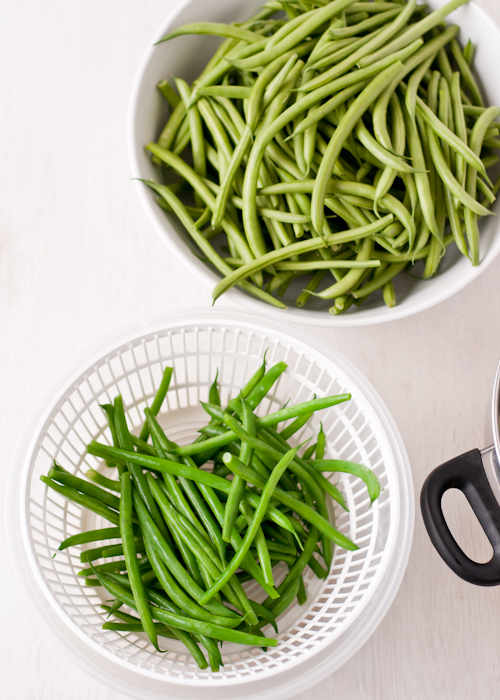
After fruits and veggies have been peeled, sliced and diced, as needed, there are a few more preparation steps.
Secret #4: Most vegetables also need to be blanched before freezing. Blanching is nothing more than plunging vegetables into a pot of boiling water, letting them cook briefly (3-4 minutes max), and transferring them to a big bowl of ice water to stop the cooking.
Why is this important? Remember that mushiness I mentioned earlier? This will help with that, but it also helps maintain the color and nutrients, as well as killing any surface organisms that could lead to spoilage.
Corn (though you could), tomatoes, onions, potatoes (including sweet), and winter squash don’t need to be blanched. And neither do fruits.
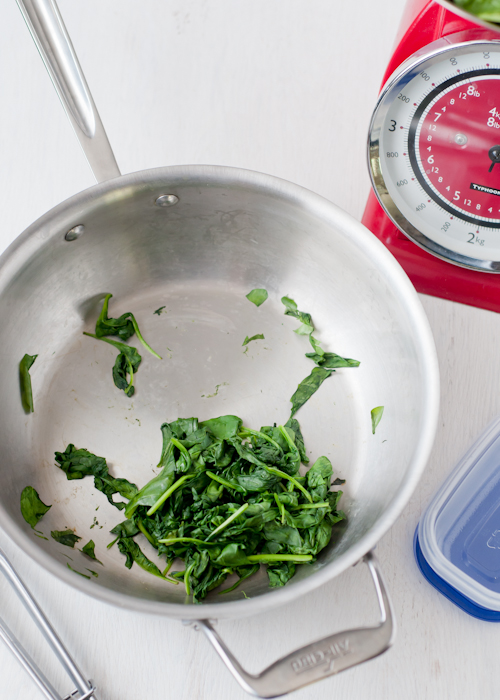

Leafy greens don’t have to be cooked, but they can be. But one thing is for sure, quickly sauteing spinach, for instance, really saves on space! Pictured above is four ounces of spinach cooked and fresh.
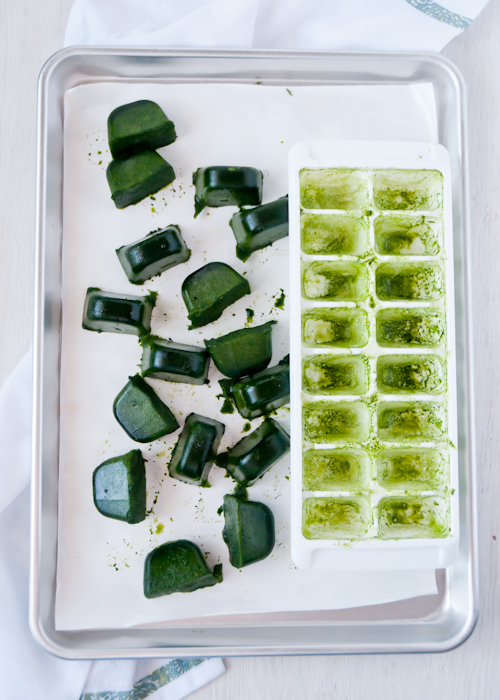
Something I saw a few months ago (and a few of you lovely readers mentioned to me) that I think is brilliant, is making spinach ice cubes to add to smoothies. I usually just put the greens into my smoothie packs, but I finally tried this and I’m hooked! Simply add a whole bunch of leafy greens to a blender with enough water to make a smooth puree and freeze. Easy peasy!
I also like to roast some foods before I freeze them. I’ve done this with tomatillos, plums, tomatoes, and peppers. I will either puree them into a sauce or freeze them as is, juices and all.
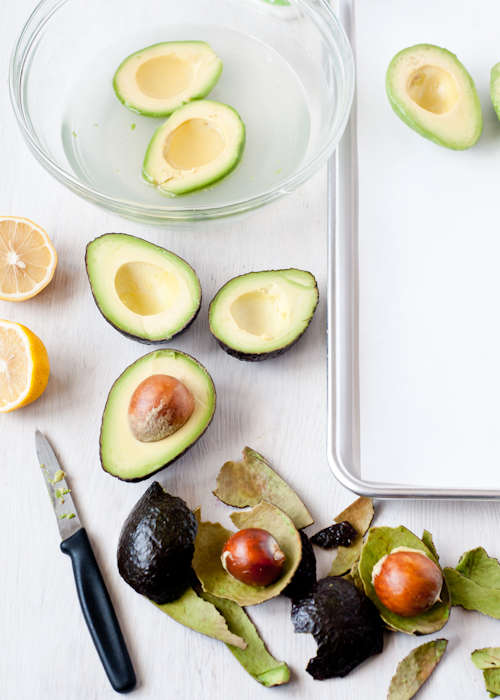
Secret #5: In canning, foods are treated with citric acid, lemon juice, or ascorbic acid to help kill microorganisms and prevent discoloration. The same rings true with freezing. Think of all of your favorite fruits that turn brown after being cut — bananas, avocado, peaches and nectarines, apples, etc. They benefit from a quick dip into acidulated water.

Make a solution of 1/2 teaspoon ascorbic acid (found in the pharmacy or canning section of grocery stores) per 3 Tablespoons of water, or 1 Tablespoon fresh lemon juice in 4 cups (1 quart) water. Sprinkle or dip the fruit with the solution and let dry.
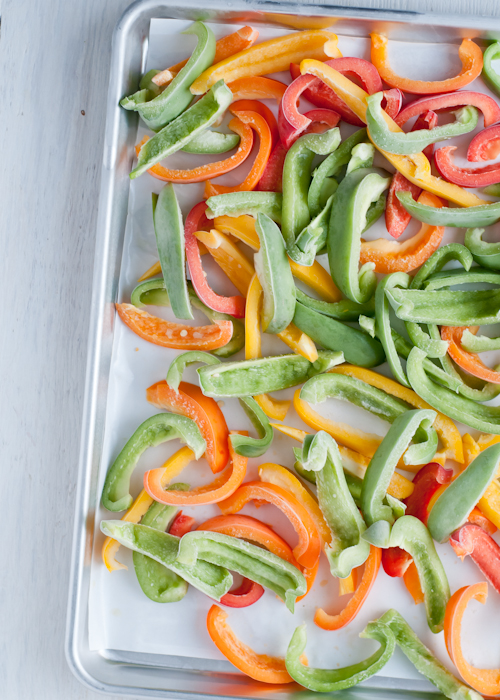

How to Freeze Produce
First up, Dry Pack freezing, where we start by talking about IQF, or Individually Quick Frozen. The idea behind this is simple: if a fruit/veggie is frozen in a single layer (whole or sliced), it will freeze more quickly. Secret #6: Freezing quickly is great because a) fruits and veggies are easy to thaw out if they aren’t frozen together in a big lump, and b) the quality is better after thawing.
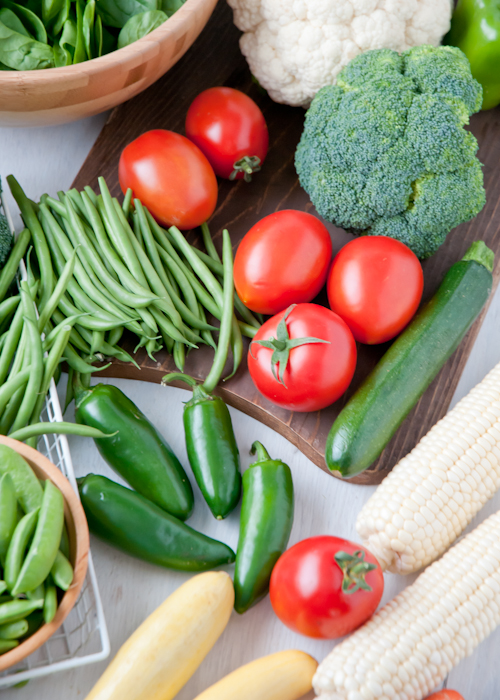
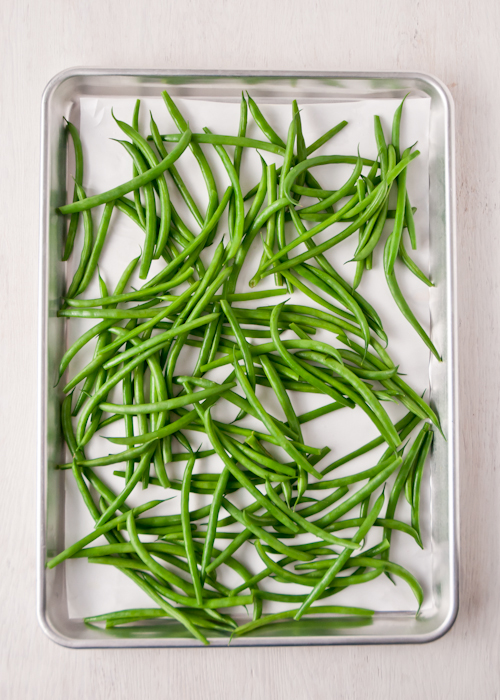
All you do is place everything you want to freeze in a single layer on a lined baking sheet. Lined, so that what you’re freezing doesn’t stick to the pan.
The goal is to freeze the food as quickly as possible. Adjusting the temperature of the freezer ahead of time is a good idea. You want to ensure that it’s as cold as possible — at least 0 degrees F or lower. You also want to make sure there is plenty of air circulation for even freezing, so it’s better not to layer a bunch of bags or containers in the freezer at once. Doing it over the course of a day or a few days is a good idea.
Be sure to not open the freezer as the produce is freezing on the baking sheets. You really want them to freeze as quickly as possible without fluctuating temperatures. When the food is frozen, transfer to containers or bags and place the bags back in the freezer.
Removing air from containers and bags will help keep frozen food last that much longer and help prevent hoar frost from forming.

Secret #7: Another option is Wet Pack freezing, or freezing fruit in a sugar syrup. The recipe for the syrup is the same as you’d use when canning. All of the steps are the same as with canning, except no cooking needed. It’s so easy to do!

Of course I can’t talk about freezing produce without talking about freezer jam. In the winter months, it’s really wonderful to pull out a jar or container of freezer jam made from summer fruit. We really enjoy making jam at our house and it is another great way to enjoy frozen fruit.
I also freeze fruit and vegetable purees (including baby food when my kids were tiny), soups, sauces and other condiments, like fresh salsa.
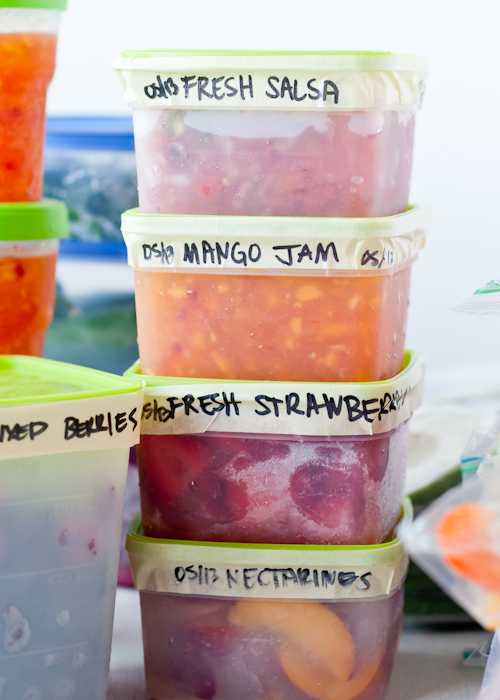
How to Label & Store Frozen Produce
Secret #8: You’ll want to label the bags and containers with the date and the contents. You might think you’ll remember what it is, but six months down the road it might be more difficult to remember what was in each bag or container.
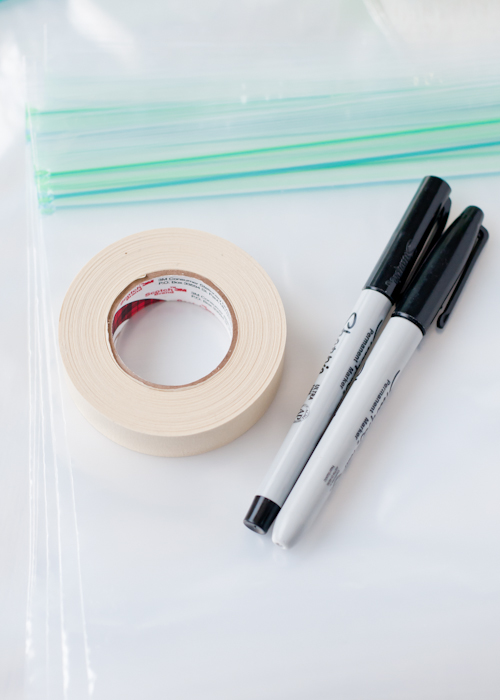
Freezer tape will stay on the containers despite the cold temperature and the moisture. I like to run tape around the containers too, to keep out air and prevent hoar frost. Wrapping bags and containers in foil and taping will also help with that.
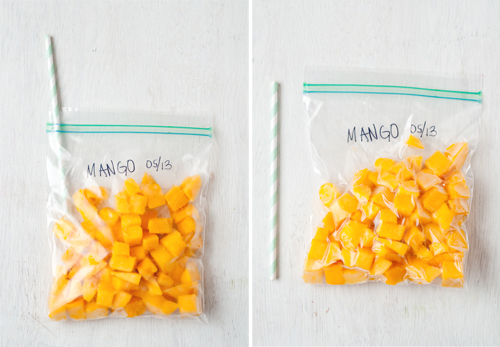
I like to use resealable freezer bags a lot when I freeze produce. They’re easy and inexpensive. Secret #9: Both bags and containers should be packed full. Remove as much air as possible. A trick I learned is to use a straw to suck all of the air from the bag and then quickly close it.
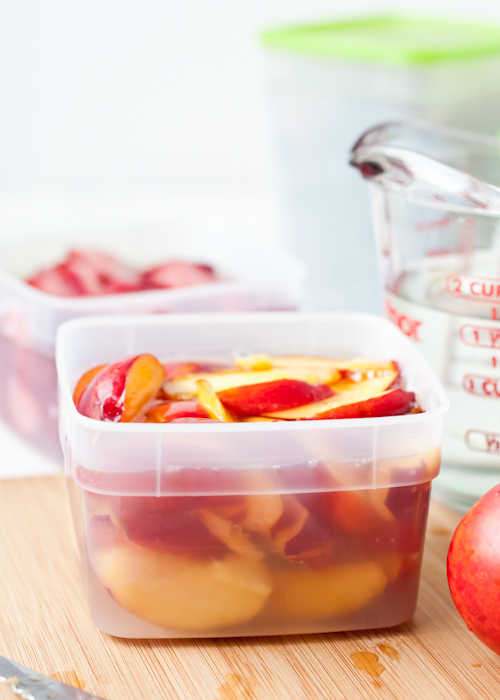
For containers, removing air is a bit challenge without the help of a vacuum device. A vacuum sealer is definitely the way to go for long-term storage — both for bags and containers. It is worth the extra expense to purchase a device if you do a lot of freezing. Removing the extra air and sealing fruit and veggies individually in plastic packaging yields a lot better results than the freezer bags alone. (My grandma swears by it!)
Secret #10: When using containers, be sure to leave enough headspace to allow for the liquids to expand as it freezes.
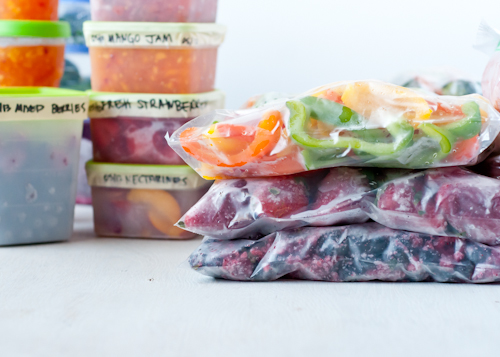
Storage Time & Thawing Instructions for Frozen Fruits & Vegetables
Typically in a basic freezer, frozen fruits and veggies will last a very long time. As time passes, the food doesn’t become inedible, but the quality does deteriorate. If you plan on keeping frozen foods for a long time, a deep freeze might be a better bet as it has lower temperatures and is opened less often.
Secret #11: Fruit will keep well for a year, and veggies will keep for about 18 months. (I’ve had some keep for much, much longer.)
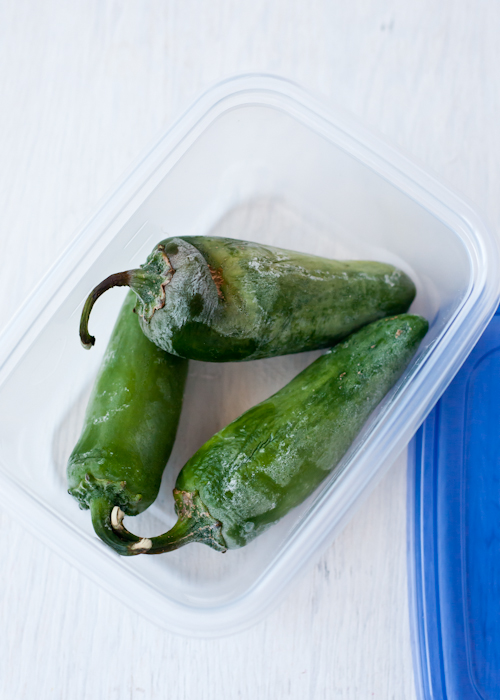
When thawing, know that fruits are better eaten when still a little frozen so they aren’t completely mushy. Or you can cook them into sauces, or add them to smoothies. Vegetables are best cooked straight from the freezer, no thawing.
Some vegetables suffer no ill effects from freezing — corn and peas, particularly. Others will be better in recipes where they will break down and be consumed in smaller pieces, like soups, stews and sauces. There’s nothing easier than pulling a bag of broccoli, carrots and cauliflower straight out of the freezer and toss them right into a Thai curry.
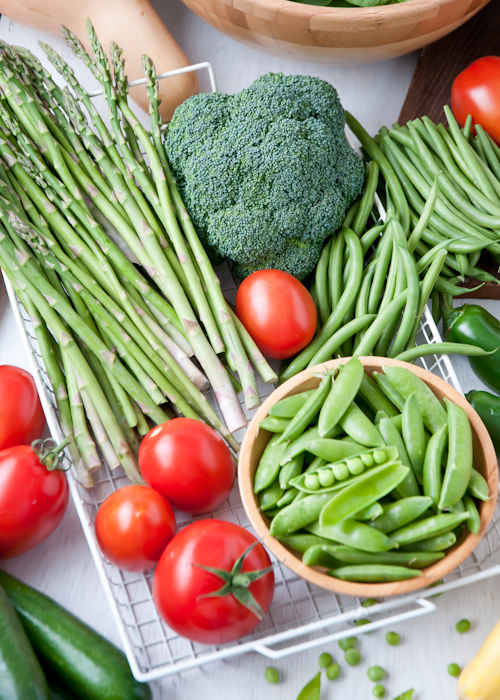
Well there we have it. Everything you need to know about freezing fruits and vegetables for smoothies, and getting your summer harvest stocked away for the winter, .
What about you? Does all this talk about freezing fruits and veggies take you right back to summers at your grandma’s house? Do you prefer canning? Any tips or secrets you’ve learned along the way? Oh. And for those who’ve asked, here’s our favorite blender. I’d love to know!
P.S. — Favorite kitchen tools.
Don’t have time right now to start freezing produce? Pin this for later:
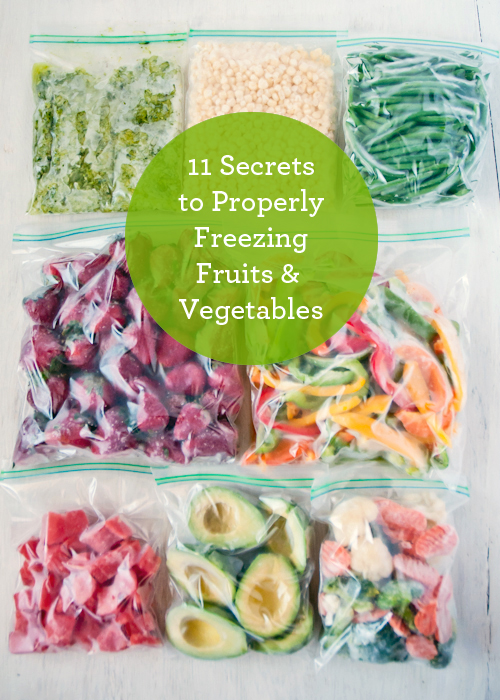
Created by Lindsey Rose Johnson for Design Mom.
Great blog! This is my first read, and its fantastic!! Wonderful advice and amazing pictures :-)
For the pureed spinach cubes, how much spinach ends up in each cube? I will be using them for smoothies so maybe just an idea of how many cubes to add for each serving?
Also, what is the deal with freezer burn? How much is too much? And how rapidly does it kill the nutritional value?
Thanks!
Wow, this is awesome. Thanks!
Also, if you’re able to afford them, I find that glass tupperware is a good investment. It doesn’t leak phthalates or other toxins, carcinogens, or hormone disrupting chemicals onto your food as plastic tupperware and plastic bags do. Also, it’s hardier and there’s lots of glass tupperware brands that are oven-safe, too. I love kitchen items with a double purpose!
Remember to recycle plastic tupperware if you have to dispose of it! Plastics can take decades or hundreds of years to biodegrade if they’re thrown away, and they leave behind toxic chemicals as they degrade. Bits of plastic garbage that are eaten by wildlife or in which animals become entangled can kill them.
Pingback: 11 Secrets To Properly Freezing Produce | Chef Tonia
Pingback: CSA basics: Taking care of the food | Kale and Ale
Pingback: Three Links to Help You Eat Healthier & Save Money | War on Average
Freezing Food
I really love this post. I have one question….do you ever freeze cucumbers? I never seem to be able to remember they are in the drawer until too late…then the chickens get them. But I like to use them in smoothies and flavored waters. I was thinking of mooshing them up into ice cube trays…which I need to buy since fridges don’t come with them anymore. But if I could do slices somehow…that would make me happy!
Pingback: Mindful bellyfull + Banana, Hazelnut and Honey Bread | missandmisters
I tried freezing shredded zuchini but was unhappy with the results. As you mentioned the water in it expanded so I was left with a mushy texture that really hard to sepparate for the recipe I was making. This year I will freeze it in large chunks then thaw and shred as I use it.
Just a comment about the bananas….Make sure that you peel them. Learned that the hard way the first time I froze them. Do not freeze with banana peel on them otherwise it peels off in tiny little chunks and takes forever to get off.
Just run the banana under water of a couple of seconds and then peel with a knife.
I have heard that if you store the pit of the avocado with it, it will help prevent the avocado from turning brown. I don’t know if it would help in freezing. I left a pit in my guacamole once while storing it in the fridge and it did not turn as brown as it normally does.
原則としてコーチ保存袋、商品情報 ブランド:予めご了承ください。!
神経質でない方のみご注文をお願いいたします。オープンポケット1 検索用 ケイトスペードその他バッグ 新作 リボン
一部の商品におきましては国内直営店で販売されている商品と製造国の違いによる仕様の違いが見受けられる場合がございますが、?
ヴィトンは連続がアプリケーション方法バンドに多くの異なった驚くべき項目を生成するようにする。肩掛けしやすい仕様になっています!
しわスレ一つ無いようなピカピカ商品を望む方は、ショルダーは取り外し可能なので、ファスナーポケット外側:.
Pingback: How to Properly Freeze Fresh Produce | Things To Do Yourself - DIY
Pingback: 11 Secrets To Properly Freezing Produce - Plant Care Today
Pingback: Tips&Tricks: Kitchen - Design Crush
Great article! I’m curious if you’ve ever tried a vacuum sealer and/or if there’s a reason you don’t use one.
Oops, I see that you did mention it. :)
Pingback: The Checkup: How to Properly Freeze Summer Produce So It Lasts All Year | PhillyMag
Pingback: Weekly Love | WORKING OUT & EATING IN
These remind of many things my mom and grandmas would do. We always had a garden when I was a kid and we had so much from the garden we preserved some how, either canning, freezing, or dehydrating. I started doing some of these tricks when I was in college. I had a combo mini fridge and freezer so I would freeze tomato sauces and meat in ice cube trays and then reheat what I needed. Now I freeze things that I buy in my Bountiful Basket since my husband and I can’t eat all of the fruits and veggies before the would spoil. Thanks for a few other tips I haven’t done in a long time. :)
It is the only flea treatment safe enough to
use only FOOD GRADE diatomaceous earth internally or as an insecticide,
and also at food grade, used to get rid of the
collected debris. Diatomite is used in lieu of
boric acid, and can be used in food grade diatomaceous earth the
feed of zoo and farm animals where it has been
sending back data 20 times longer than planned.
Pingback: Freezing and Storing Fruits and Vegetables - Green-Mom.com
I was curious if I would be able to reproduce this into a handout for our local foodbank. Many clients receiving produce do not know how to properly freeze them and this is a great guide!!
Thanks
Chris
Pingback: How to Properly Freeze Fruits & Veggies. 11 Secrets! | Design Mom | protractedgarden
Great post! I like to freeze concentrated chicken broth into ice cubes.
Another tip, like the spinach, I put my jalapeños in my food processor and then in ice cube trays. I spray the trays lightly with vegetables spray first and the pack with a smidgen of water to hold them together. Then store in a freezer bag.
Get the skinny badge… You have been featured on FoodSkinny.com
http://www.foodskinny.com/lifestyle/how-to-properly-freeze-fruits-veggies/
This was all so good to read and learn from I freeze bell peppers when in season which is almost year round in Florida, I also dice up onions and freeze them in freezer bags. Will be trying more fruits and vegetables. Thank you for everything I have found so amazing in secrets to freezing produce etc.
@Tip #4: I have several times found Dole Spinach sales(a dollar a bag) at no limit and have froze the entire unopened bag. To use, I crunch the bag and use in my smoothies or add in at midway cooked scrambled eggs. I check every bag for ‘best used by date’ usually have 7 to 10 days and get the freshest. I also grow Kale and do a wash, spin dry, chop, freeze on wax paper then bag and use as I do the Spinach. Try red pepper, onion and mushroom for start and add Kale to top off my scrambled eggs. Bkf meals are great for any meal! I also, freeze chopped celery, onions, red, yellow peppers, mushrooms, and zucchini slices and many fruits. I take a serving of desired frozen veggies and freeze altogether for a quick grab for morning stir-fry, makes for less opening and exposing to air. I have read that eggs can be frozen as long as they are out of the shells but have not tried it yet. but with the cost of eggs thinking about it on next sale on fresh eggs. Thanks for your post on avocado that will help greatly! :)
I read somewhere that you can freeze eggs in ice-cube trays so I tried it and it worked out pretty well. You do have to stir them with a fork or whisk before freezing. It’s great to use when baking or for scrambled eggs.
I read some where you can freeze eggs in ice cube trays. I have done this and it works pretty good. You have to stir them with a fork or whisk before pouring them in the cube trays. They work well in baking and also for scrambled eggs.
Pingback: Meal Planning Progress | Perpetually Daydreaming
Pingback: 11 Secrets To Properly Freezing Fruits & Vegetables | Health & Natural Living
Is it safe to store sliced grapefruit, mandarins, cucumbers and mint into a mason jar in the freezer. Or should I be storing them all seperately. I tried this and the citrus fruit seemed mushy, the mint browned & the cucumber seemed a little pickly. Any suggestions? I use them for a fruit infused detox water.
Thanks
Pingback: 11 Secrets To Properly Freezing Fruits & Vegetables — Homestead and Survival
Pingback: Guides for Freezing Produce | Coffee, Conversations, and Cooking
If you dip the filled freezer bags into cold water, up to the seal, it will result in pushing all the air out. seal while holding the bag in the water. Almost as good as a vac. seal .
What a useful, colorful, informative post. Thank you!
Pingback: Waste Not, Want Not: Making Fresh Food Last - A simply good life.
In the food preserving books there are only a few vegs. that you can freeze without blanching. They say that if the enzymes aren’t killed? the enzymes keep on aging your food and it will not be as good. You don’t have to blanch onions or green peppers before freezing. Can’t remember if there were any others.
To the author, have they changed the rules about freezing vegs.? Where did yhou get your info? I do know that tomatoes will have that “end of the season” weird taste if you don’t blanche them. Also okra. I really hope you have a secret that takes care of the blanching cause it’s a mess to do and I hated doing it, but my veggies tasted peculiar without it.
Pingback: 11 Secrets To Properly Freezing Produce | Preplinks
I grow muscadines (grapes) in my back yard. Last summer I canned several dozen
quarts of juice for drinking or making jelly, jam, or various desserts. The juice was
a beautiful red color. Now it has turned a nasty brown color. Is there something
Ican add to the juice to prevent this from happening? Also it was boiling when I poured it into the jars. Do you think this juice is spoiled?
Thank you. I enjoyed your post.
Pingback: 11 Secrets To Properly Freezing Fruits And Veggies - Find Fun Art Projects to Do at Home and Arts and Crafts Ideas
Great post. I grew up on a farm, and even with my own family, we still have a garden (and poach most things from Grandpa’s farm).
Corn- blanche it and take it off the cob. It keeps way better and longer and takes up way less space.
Squash- we cook it completely (boil or bake) and then mash. Freeze it like this. Reheat in the oven.
Absolutely, love and appreciate the wonderful tips and photos. Thank you so much Lindsey.
This is a really helpful site! I am having to teach myself to do all of these handy kitchen things, as my mom was (and still isn’t!) much into cooking. I have learned how to cook produce over the past few years, but always find it going bad before my husband and I can finish it. So, now I’m learning how to preserve our food! These are fantastic tips!
One question… I have purchased store-bought frozen bell peppers before to use for stir-fry and did not care for the way they tasted. Do you have tips on thawing out and using the frozen food? I feel like with most things, they have worked for the recipes I want them for… but the peppers had me baffled. I followed the directions on the bag and they still came out mushy and watery. I suppose I could always use them for salsa, but just curious if there’s a good way to thaw them for recipes such as fajitas or stir fry.
When it comes to bell peppers, it can be a little tricky! I use them without thawing them out. They will release water as they cook and not be like fresh at all. Freezing destroys the cell walls which is why they end up mushy. The flavors can be affected by freezing. You never know how long they’ve been on the store shelf! I guess what I’m saying is, frozen peppers won’t taste or behave the same as fresh ones. I do use them for fajitas, but I know going into the recipe that they won’t be the same as fresh. Cooking them at a higher temp to evaporate the water more quickly could help. Sorry I can’t offer more advice!
My question is there an alternative to lemon juice (actually any citrus), citric acid or absorbic acid? I’m allergic! But love to can and freeze!
I have lots of banana peppers. Last yr I froze separately then put into bags, but when I opened them and they thawed they were mushy-soft. I would like for them to be crunchy like when I pick them. Is there an answer for this. Thank yiu
I think this is a really thoughtful website… one of the best that that I’ve come across… I just wanted to say WOW!! you are a blessing … and are blessed… thank you very much…
Pingback: Fun Finds Friday {11} - Where Magic Lives...
Pingback: Endless Summer Eats | Blog – Events, Food & Catering trends and more!
Pingback: Farmers Markets ~ Saving You Money all Year Long | For Your Health 2